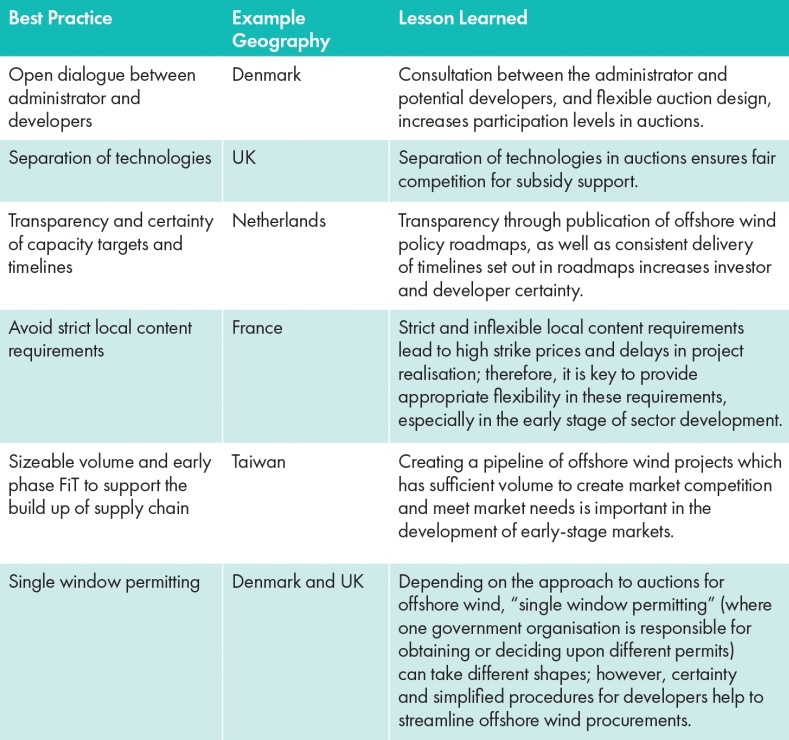Making progress for Vietnam’s offshore wind farms
 |
| Best practices for offshore wind auctions |
However, under the current development pipeline, the first true large-scale offshore wind projects are not likely to be connected to the grid until 2026 or later, and they lack a clear regulatory framework to support their development.
The infancy of the offshore wind sector in Vietnam means that policy is still being formulated, and it is incredibly important to ensure that future policy is designed for steady and sustainable growth, providing sufficient time for the offshore wind industry to take off and mature.
Offshore wind is one of the fastest-growing energy sectors in the world, and is set to be a transformative force for the global energy transition. Its success has been driven by its rapid deployment in Europe, incredible cost reduction, and consistent record of technological innovation.
The same success will surely be replicated in Asia. Offshore wind is an optimal technology which can supply clean energy, alleviate air pollution, and deliver the most decarbonisation firepower as a displacement technology for fossil fuels. Its high capacity factors, particularly in a country with abundant offshore wind resources like Vietnam, make it a secure and scalable source of power. As a domestic source, offshore wind can increase energy security and improve balance of trade by avoiding dependency on fuel market fluctuations.
Moreover, the industry can be a source of massive inward capital investment, job creation, and industrial development. It is in this context that we published a report and recommendations for Vietnam’s future offshore wind procurement, and specifically a transition to competitive auctions in this decade. With less than 10 years to meet the country’s Power Development Plan VIII goals for 2030, the time is now to begin consultation for offshore wind procurement.
Offshore wind is a complex industry and there are many lessons for Vietnam to learn from other markets when considering its auction policy. A key recommendation for Vietnam is to establish the industry through a feed-in tariff (FiT) and transition to an auction process at the 4-5GW mark. Auctions are a good tool for governments to control offshore wind tariffs, once the industry is stable.
An efficient and streamlined permitting process will be key to deploy new offshore wind capacity quickly in Vietnam to build up the market, while simultaneously helping to meet the country’s ever-growing energy demand, reducing expensive energy imports, and avoiding millions of tonnes of carbon emissions.
“Global experience yields valuable recommendations for Vietnam’s nascent offshore wind sector, especially at this crossroads where the country’s energy system decisions will make the difference between a clean energy future and locking in carbon-intensive generation,” said Joyce Lee, GWEC head of Policy and Projects. “The new report puts forth several concrete recommendations around the timing and transition from an offshore wind FiT, planning frameworks, auction design, and more. Proactive efforts and cooperation in each area could support a larger and more sustainable pipeline of projects towards 2030.”
What the stars mean:
★ Poor ★ ★ Promising ★★★ Good ★★★★ Very good ★★★★★ Exceptional
 Tag:
Tag:
Themes: COP26 - Together for Our Planet
Related Contents
Latest News
More News
- Honda launches electric two-wheeler, expands charging infrastructure (January 12, 2026 | 14:00)
- Vietnam striving to ease air pollution (January 09, 2026 | 14:41)
- Petrovietnam Gas awards first multi‑year LNG deal to Shell (January 09, 2026 | 14:38)
- Advancing the net-zero journey: Carlsberg Vietnam’s sustainability progress in 2025 (January 09, 2026 | 09:49)
- The green hydrogen and ammonia future for Vietnam (January 06, 2026 | 15:03)
- Green transition to close $20 billion annual investment gap (December 31, 2025 | 11:59)
- Australia contributing to Vietnam’s climate change responses (December 30, 2025 | 11:37)
- CME Solar strengthens position in Vietnamese renewables (December 30, 2025 | 11:21)
- Self-care signals shift towards sustainable healthcare (December 30, 2025 | 10:12)
- GreenYellow marks five years of clean energy growth in Vietnam (December 26, 2025 | 15:51)























 Mobile Version
Mobile Version